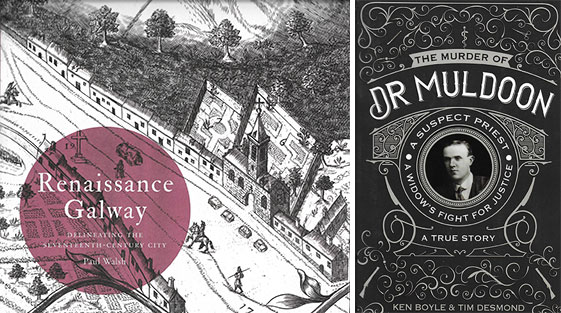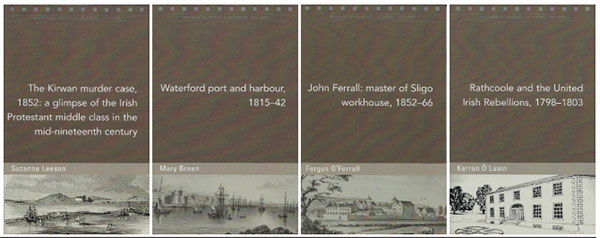BOOKWORM
Published in Book Reviews, Book Reviews, Issue 6 (November/December 2019), Volume 27By Joe Culley
@TheRealCulls
Anyone who has spent time in Galway will be familiar with the ‘pictorial map’ of the early modern town, a ‘bird’s-eye’ illustration detailing with remarkable accuracy the street layout and the significant buildings and landmarks of the time. A print of the map is framed on the walls of nearly every pub in the city. Now local archaeologist Paul Walsh, as part of the RIA’s Irish Historic Towns Atlas, has produced Renaissance Galway: delineating the seventeenth-century city, which breaks up the map into 38 component parts for forensic study. It is a remarkable and wonderful piece of work.
Now, I confess a bias here, for I was lucky enough to live in Galway for most of the 1980s, when the place was still just a big town rather than the metropolis it has become. Indeed, I lived in the even more parochial Claddagh, which I was intrigued to discover is designated the ‘Southern Suburb’ on the map.
The exact year of the map’s completion is uncertain, but it was clearly soon after the restoration of Charles II, for much of the text stitched into it goes out of its way to confirm fealty to the king. The primary intention in producing this large wall-hanging, however, had been to celebrate the wealth and power of the town’s Catholic burghers before they surrendered to parliamentary forces in 1652. Walsh explains in his introduction that, as accurate as the map appears, not everything can be taken at face value. And while it was intended to celebrate the accomplishments of the town’s ruling Catholic élite, it was in fact a representation of a world that no longer existed.
As Walsh zooms in on the details, one can see that many of the figures are rendered in an almost comic-book fashion. The 38 commentaries allow Walsh to embellish the social and cultural significance of familiar landmarks, such as Martin Brown’s townhouse, the façade of which now stands sentinel at the top of Eyre Square, or the square itself, which is shown as ‘The Green’ and was outside the town walls. There is much to savour here and, with the holy season of book-giving imminent, this is perfect for the Galwegian in your life.
Another publication sure to be a hit in the coming season is The murder of Dr Muldoon, a true story: a suspect priest, a widow’s fight for justice by Ken Boyles and Tim Desmond. It’s early 1923 and a popular young doctor is shot dead on the street in Mohill, Co. Leitrim. Right from the off a prime suspect is a parish priest, Fr Ryans, an unstable anti-Treaty activist who is also facing charges of attempting to abandon the newborn child of his young, unmarried housekeeper. The book grew out of a 2017 RTÉ radio documentary, and the authors do a fine job of uncovering and separating the various strands of Church, State and IRA involvement in the conspiracy. A bit of a page-turner.

Staying on the cold-case murder theme, one of the most sensational in nineteenth-century Ireland arose when a popular artist was tried over the death of his wife, Sarah, on Ireland’s Eye, across from Howth harbour. In The Kirwan murder case, 1852: a glimpse of the Irish Protestant middle class in the mid-nineteenth century, Suzanne Leeson focuses on the press coverage and public reaction to the murder to examine what they tell us about the strata of society to which William Kirwan belonged.
Spoiler alert: although he was defended by no less a figure than Isaac Butt, Kirwan was found guilty purely on circumstantial evidence and sentenced to death, commuted to life. He was also supported by some of his Merrion Square neighbours, leading physicians of the ‘Dublin school of medicine’. There had been several earlier reports of domestic abuse, however, and he was described as a ‘thoroughbred poltroon’, not least for having a mistress and seven children in Sandymount.
In the end, Kirwan was kept in prison for far longer than normal, owing in part to sectarianism—the Catholic Church was particularly scathing about the crime and the criminal—and the sensational nature of the case. Leeson also looks at how the trial fits in with the evolution of the laws on both divorce and criminal appeal. A nice read.
Leeson’s book is No. 141 in the always-interesting Maynooth Studies in Local History series, which for many years has been produced by Four Courts Press. They print between 700 and 1,000 copies of each book, and they are, not surprisingly, hugely popular in each particular locale. Indeed, Four Courts say that around 80 of the titles have effectively sold out. They are also available in the local libraries. As an example, this tranche of releases includes Mary Breen’s Waterford port and harbour, c. 1815–42, which is already nearly sold out. Also newly released is Kerron Ó Luain on Rathcoole and the United Irish Rebellions, 1798–1803, while Fergus O’Ferrall, whom you may know from earlier work on O’Connell, delves into the career of John Ferrall: master of Sligo workhouse, 1852–66. The master was the brother of the author’s great-grandfather, and Ferrall uses this study to examine how workhouse policies evolved after the Famine.

Another likely stocking-filler is Barry Kennerk’s The peeler’s notebook: policing Victorian Dublin: mad dogs, duels and dynamite. Kennerk has trawled the archives to produce an entertaining miscellany of tales about the challenges faced by the Dublin Metropolitan Police, from tenement mobs to Fenians to sewer gases.
 With his newest publication, the prolific Fr Thomas Morrissey SJ engages with the genre of ‘spiritual biography’ to tell the story of Dom Eugene Boylan: Trappist monk, scientist and writer. In the 1940s the Derry-born monk published two books, This tremendous lover (i.e. God) and Difficulties in mental prayer, which became international best-sellers. He also travelled widely as a speaker and, indeed, impressed Thomas Merton in Kentucky. In 1962 he became abbot at Roscrea, but eighteen months later died from injuries received in a car crash. Fr Morrissey uses his easy style to focus on Boylan’s inspirational spirituality.
With his newest publication, the prolific Fr Thomas Morrissey SJ engages with the genre of ‘spiritual biography’ to tell the story of Dom Eugene Boylan: Trappist monk, scientist and writer. In the 1940s the Derry-born monk published two books, This tremendous lover (i.e. God) and Difficulties in mental prayer, which became international best-sellers. He also travelled widely as a speaker and, indeed, impressed Thomas Merton in Kentucky. In 1962 he became abbot at Roscrea, but eighteen months later died from injuries received in a car crash. Fr Morrissey uses his easy style to focus on Boylan’s inspirational spirituality.
Paul Walsh, Renaissance Galway: delineating the seventeenth-century city (Royal Irish Academy, €12 pb, 100pp, ISBN 9781911479079).
Ken Boyle and Tim Desmond, The murder of Dr Muldoon, a true story: a suspect priest, a widow’s fight for justice (Mercier Press, €12.99 pb, 252pp, ISBN 9781781176900).
Suzanne Leeson, The Kirwan murder case, 1852: a glimpse of the Irish Protestant middle class in the mid-nineteenth century (Four Courts Press, €8.95 pb, 64pp, ISBN 9781846828010).
Mary Breen, Waterford port and harbour, c. 1815–42 (Four Courts Press, €8.95 pb, 64pp, ISBN 9781846828003).
Fergus O’Ferrall, John Ferrall: master of Sligo workhouse, 1852–66 (Four Courts Press, €8.95 pb, 64pp, ISBN 9781846828034).
Kerron Ó Luain, Rathcoole and the United Irish Rebellions, 1798–1803 (Four Courts Press, €8.95 pb, 64pp, ISBN 9781846828041).
Barry Kennerk, The peeler’s notebook: policing Victorian Dublin: mad dogs, duels and dynamite (Mercier Press, €14.99 hb, 203pp, ISBN 9781781177099).
Thomas J. Morrissey SJ, Dom Eugene Boylan: Trappist monk, scientist and writer (Messenger Publications, €19.95 pb, 170pp, ISBN 9781788120258).


















